Water Quality in the Central Columbia Plateau, Washington and Idaho, 1992-95
Table of contents || Previous section || Next section || Glossary

Yellow areas indicate other NAWQA Study Units sampled during 1992-95.
Seven major water-quality characteristics were evaluated for stream sites in each NAWQA Study Unit. Summary scores for each characteristic were computed for all sites that had adequate data. Scores for each site in the Central Columbia Plateau were compared with scores for all sites sampled in the 20 NAWQA Study Units during 1992-95 (see map at left). Results are summarized by percentiles; higher percentile values generally indicate poorer quality compared with other NAWQA sites. Water-quality conditions at each site also are compared to established criteria for protection of aquatic life. Applicable criteria are limited to nutrients and pesticides in water, and semivolatile organic compounds, organochlorine pesticides, and PCBs in sediment. (Methods used to compute rankings and evaluate aquatic-life criteria are described in reference 38.)
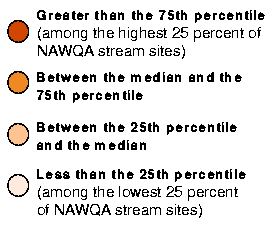
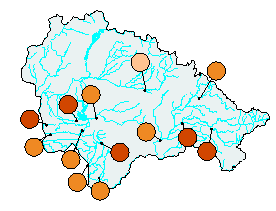
Nutrient levels are greater than the national median at all but one site, with 5 of 13 sites in the upper 25 percent of NAWQA sites. Elevated nutrient concentrations, primarily caused by fertilizer application on fields upstream of most sites and municipal wastewater at a few sites, are causing eutrophication. Effects of eutrophication include reduced dissolved oxygen, which can adversely affect fish, and nuisance growth of aquatic plants.

Many pesticides (12-45) were detected at four sites; the detection frequency at one of the sites is in the upper 25 percent of NAWQA sites. The two sites with the highest detection frequencies are in the Quincy-Pasco subunit, where irrigation and high chemical use combine to increase transport of pesticides to surface waters. Pesticide detection frequencies at sites in the dryland farming areas of the North-Central and Palouse subunits are below the national median for NAWQA sites. All of the sites had at least one pesticide concentration that exceeded a water-quality standard or guideline.

Concentrations of organochlorine pesticides and PCBs are higher than the national median (50th percentile) at 7 of 11 sites, with 4 sites in the upper 25 percent of all NAWQA sites. Elevated concentrations were observed in dryland farming areas as well as in irrigated areas. One or more environmental guidelines were exceeded at one of the sites in the Palouse River basin that is affected by urban wastewater as well as at Lind Coulee. Although most of these compounds have been banned, they still persist in the environment.

Trace elements, such as the metals lead and chromium, are low in the Central Columbia Plateau compared to other NAWQA Study Units because of the minimal influence of mining and urban sources and the low natural background concentrations in soils. All sites have trace element levels below the national median for NAWQA sites.

At 7 of 11 sites, concentrations of semivolatile organic compounds are lower than the national median. Three of four sites in the Palouse River drainage basin have levels in the lowest 25 percent of NAWQA sites. At Crab Creek near Beverly in the Quincy-Pasco subunit, levels are in the upper 25 percent of NAWQA sites.

All 16 sites for which stream habitat degradation was evaluated in the Central Columbia Plateau showed some signs of habitat degradation; 44 percent are in the upper 25 percent. Streams in this Study Unit area have an average of only 20 percent canopy cover, with most having far less. The loss of riparian vegetation, combined with other land use practices, has resulted in streams having an average of 70 percent bank erosion. These factors, combined with high nutrient and sediment loading, have resulted in the majority of streams in this Study Unit having habitat conditions that are unsuitable for many native species.
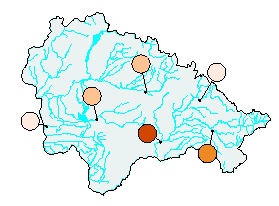
Fish community degradation in the Central Columbia Plateau varies across the national range. Fish communities can be influenced by multiple factors, including pesticides, increased aquatic plant growth due to nutrients, reduced riparian habitat, and sediment runoff from agricultural practices. The two sites with the most impacted fish communities were a wastewater-dominated urban stream and a large dryland farming stream. Small dryland streams associated with spring systems contained the most trout.
In the Central Columbia Plateau, compared to other NAWQA Study Units:
High levels of nutrients, primarily from fertilizer, are causing eutrophication.
Levels of pesticides in water and organochlorine compounds in bed sediment and fish tissue are relatively high: at all four sites where pesticides in water were measured over one year, a median concentration exceeded a freshwater-chronic criterion in at least one month; at 2 of 11 bed sediment sites, one or more organochlorine compounds exceeded an aquatic-life guideline.
Habitat degradation is relatively high: seven of sixteen sites are in the upper 25th percentile, mainly because of reduced canopy cover and increased bank erosion.
Fish community degradation is moderate.
Levels of trace elements and semivolatile organic compounds in bed sediment are relatively low.

Yellow areas indicate other NAWQA Study Units sampled during 1992-95.
Five major water-quality characteristics were evaluated for ground-water studies in each NAWQA Study Unit. Ground-water resources were divided into two categories: (1) drinking-water aquifers, and (2) shallow ground water underlying agricultural or urban areas. Summary scores were computed for each characteristic for all aquifers and shallow ground-water areas that had adequate data. Scores for each aquifer and shallow ground-water area in the Central Columbia Plateau were compared with scores for all aquifers and shallow ground-water areas sampled in the 20 NAWQA Study Units during 1992-95 (see map at left). Results are summarized by percentiles; higher percentile values generally indicate poorer quality compared with other NAWQA ground-water studies. Water-quality conditions for each drinking-water aquifer are also compared to established drinking-water standards and criteria for protection of human health. (Methods used to compute rankings and evaluate standards and criteria are described in reference 38.)



Median nitrate concentrations in deeper public supply wells are below the national median (50th percentile) for NAWQA drinking water sites. Shallow ground water associated with agricultural land use (wheat, orchards, and potatoes) have median nitrate concentrations that are in the upper 25 percent of NAWQA study median values. In the Central Columbia Plateau, high nitrate concentrations are due primarily to high rates of fertilizer application. Grazing and application of food processing-plant wastes are lesser influences.
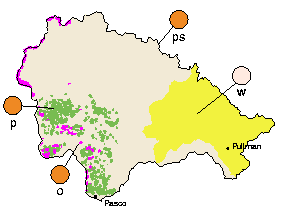
At three of four sites, pesticide detection frequencies in ground water were greater than the national median. Detection frequencies varied in shallow wells depending on the land use. Pesticide detections associated with potatoes are above the national median, but lower than those associated with orchards. The lowest pesticide detection frequency in shallow ground water was in the Palouse subunit, where wheat is the dominant crop.

Concentrations of volatile organic compounds (VOCs) in both public supply wells and the more shallow land use wells are generally higher than the national median. The high application rate of fumigants on potatoes may explain the high concentrations of VOCs in the irrigated Quincy-Pasco subunit. Concentrations of several compounds (primarily older, discontinued fumigants) exceed water-quality standards or guidelines in land use wells in the Quincy-Pasco subunit.
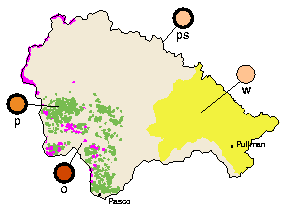
Dissolved solids in the public supply wells and in the more shallow, dryland farming Palouse subunit wells are below the national median for NAWQA sites. In contrast, dissolved-solids concentrations are greater than the national medians for both potatoes and orchards, with orchards in the upper 25 percent of NAWQA sites. The higher levels in the Quincy-Pasco subunit reflect the influence of irrigation water.

Radon, a decay product of radium, occurs naturally in soils (see p. 12 ). Radon concentrations in public supply wells and potato land use wells are below the national median for NAWQA sites. Wells associated with orchards in the Quincy-Pasco subunit and dryland wheat in the Palouse subunit exceed the national median.
In the Central Columbia Plateau, compared to other NAWQA Study Units:
Nitrate concentrations in ground water are high, with more than 20 percent of the wells exceeding the drinking water standard.
Pesticides, though frequently detected, are generally at concentrations less than 10 percent of drinking water standards. However, pesticide-related health risks are difficult to assess because standards do not exist for about 40 percent of the pesticides analyzed, or for combinations of pesticides.